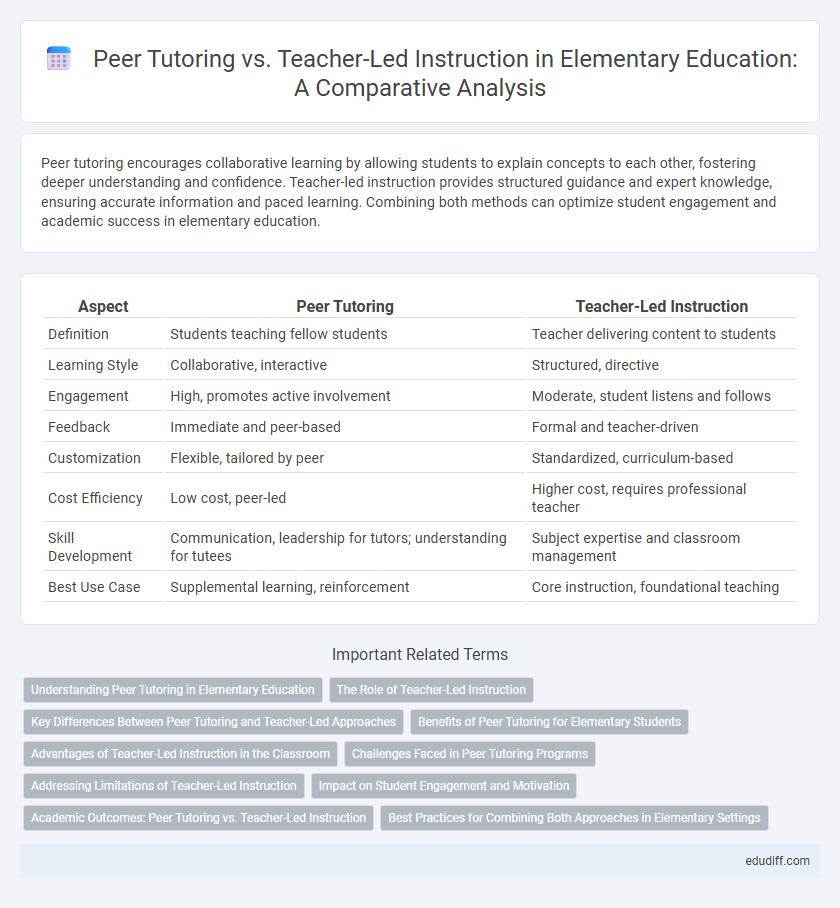Peer tutoring encourages collaborative learning by allowing students to explain concepts to each other, fostering deeper understanding and confidence. Teacher-led instruction provides structured guidance and expert knowledge, ensuring accurate information and paced learning. Combining both methods can optimize student engagement and academic success in elementary education.
Table of Comparison
| Aspect | Peer Tutoring | Teacher-Led Instruction |
|---|---|---|
| Definition | Students teaching fellow students | Teacher delivering content to students |
| Learning Style | Collaborative, interactive | Structured, directive |
| Engagement | High, promotes active involvement | Moderate, student listens and follows |
| Feedback | Immediate and peer-based | Formal and teacher-driven |
| Customization | Flexible, tailored by peer | Standardized, curriculum-based |
| Cost Efficiency | Low cost, peer-led | Higher cost, requires professional teacher |
| Skill Development | Communication, leadership for tutors; understanding for tutees | Subject expertise and classroom management |
| Best Use Case | Supplemental learning, reinforcement | Core instruction, foundational teaching |
Understanding Peer Tutoring in Elementary Education
Peer tutoring in elementary education involves students teaching or assisting their classmates under minimal teacher supervision, fostering collaborative learning and enhancing comprehension. This approach leverages peer interaction to build communication skills and mutual understanding, promoting active engagement and personalized support. Research indicates peer tutoring improves academic achievement and social development by encouraging responsibility and confidence among young learners.
The Role of Teacher-Led Instruction
Teacher-led instruction provides structured guidance and expert knowledge that supports foundational skill development in elementary students. It ensures curriculum standards are met while allowing teachers to adapt lessons to individual learner needs based on ongoing assessments. This method enhances classroom management and promotes a consistent learning environment essential for early academic success.
Key Differences Between Peer Tutoring and Teacher-Led Approaches
Peer tutoring involves students teaching their classmates, promoting collaborative learning and personalized support, while teacher-led instruction centers on direct teaching from educators to the whole class. Peer tutoring enhances communication skills and peer relationships, whereas teacher-led methods ensure structured lessons backed by professional expertise. The key differences lie in the dynamic of interaction, with peer tutoring fostering peer engagement and teacher-led instruction providing expert guidance.
Benefits of Peer Tutoring for Elementary Students
Peer tutoring in elementary education enhances student engagement by promoting active learning and collaboration among peers. It supports personalized instruction, allowing students to progress at their own pace while reinforcing their understanding through teaching others. Research shows that peer tutoring improves academic performance, boosts self-confidence, and develops critical social skills essential for overall student growth.
Advantages of Teacher-Led Instruction in the Classroom
Teacher-led instruction provides structured guidance, ensuring that elementary students receive clear explanations and immediate feedback, which enhances their understanding of fundamental concepts. It allows educators to tailor lessons to the specific learning needs of the classroom, promoting consistency and curriculum alignment. This approach also fosters classroom management and discipline, creating an environment conducive to focused learning.
Challenges Faced in Peer Tutoring Programs
Peer tutoring programs in elementary education often face challenges such as inconsistent tutor preparation, which can lead to uneven instructional quality and reduced student engagement. Managing diverse learning paces among peers complicates maintaining effective collaboration and personalized support. Additionally, limited teacher supervision during peer interactions can hinder timely identification and correction of misunderstandings.
Addressing Limitations of Teacher-Led Instruction
Peer tutoring effectively addresses limitations of teacher-led instruction by promoting personalized learning through student interactions, which enhances understanding and engagement. It alleviates teacher workload and allows more individualized attention for struggling students. Studies show peer tutoring improves academic outcomes and social skills, complementing traditional methods.
Impact on Student Engagement and Motivation
Peer tutoring in elementary classrooms significantly boosts student engagement by promoting active participation and collaborative learning, making lessons more relatable and interactive. Teacher-led instruction provides structured guidance but may limit student motivation due to passive learning roles. Research shows peer tutoring increases students' confidence and interest in subjects, driving higher academic achievement and sustained motivation.
Academic Outcomes: Peer Tutoring vs. Teacher-Led Instruction
Peer tutoring in elementary education often enhances academic outcomes by promoting personalized learning and deeper engagement compared to traditional teacher-led instruction. Studies show that peer tutoring improves reading comprehension, math skills, and overall academic achievement by encouraging active participation and collaborative problem-solving. Teacher-led instruction remains essential for structured content delivery and foundational knowledge, but integrating peer tutoring can boost student performance and confidence.
Best Practices for Combining Both Approaches in Elementary Settings
Integrating peer tutoring with teacher-led instruction enhances elementary students' engagement and comprehension through diversified learning interactions. Effective practices include structured peer roles guided by teacher oversight to ensure clarity and accuracy in content delivery. Combining collaborative peer discussions with targeted teacher feedback fosters a balanced environment that supports both social development and academic achievement.
Peer Tutoring vs Teacher-Led Instruction Infographic

 edudiff.com
edudiff.com